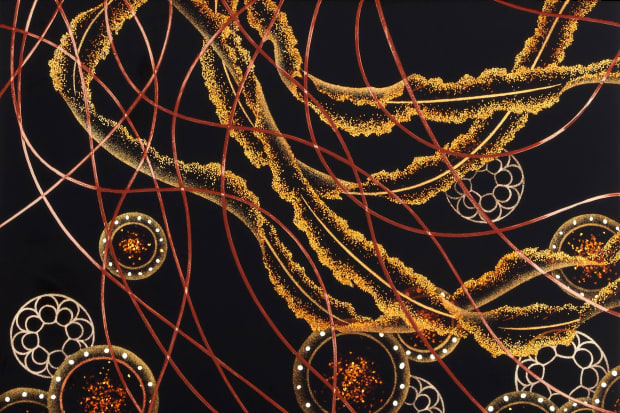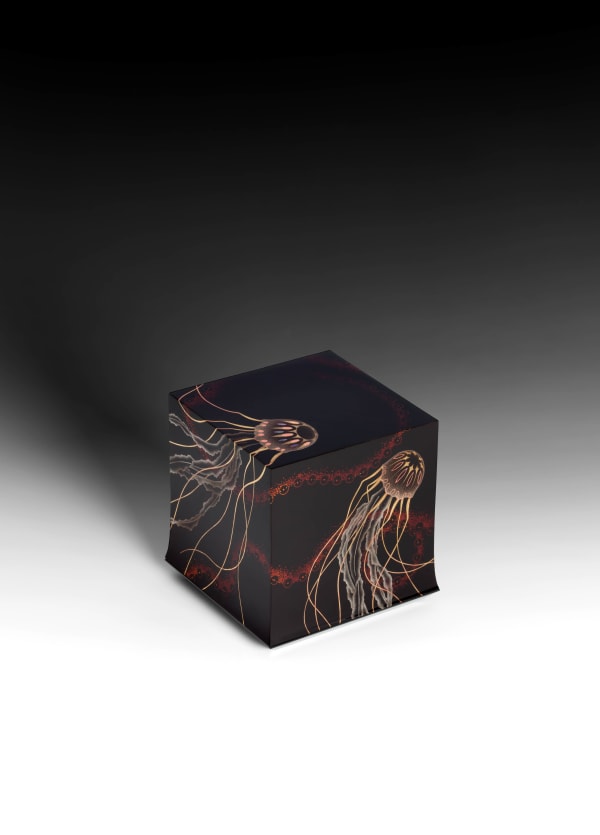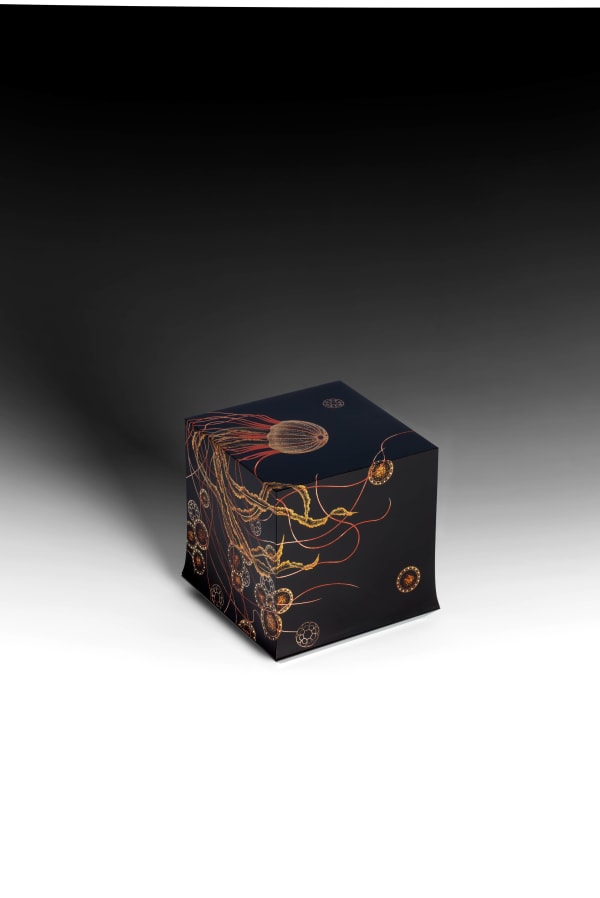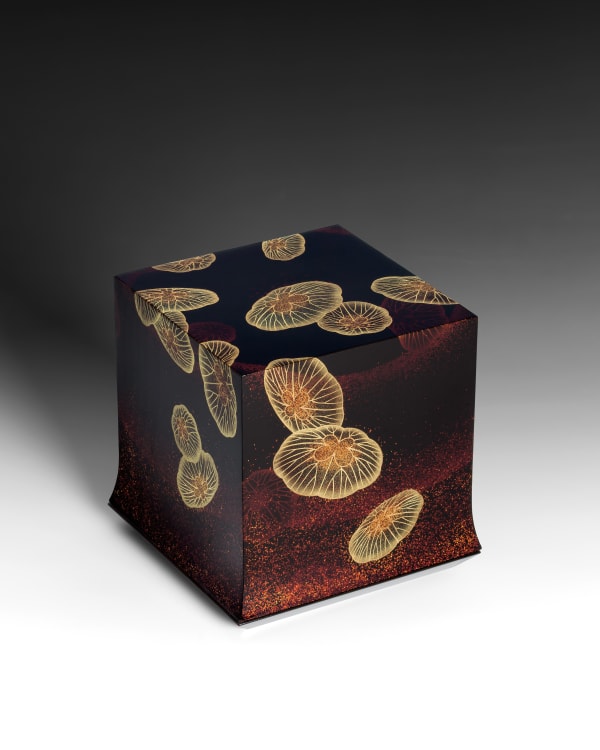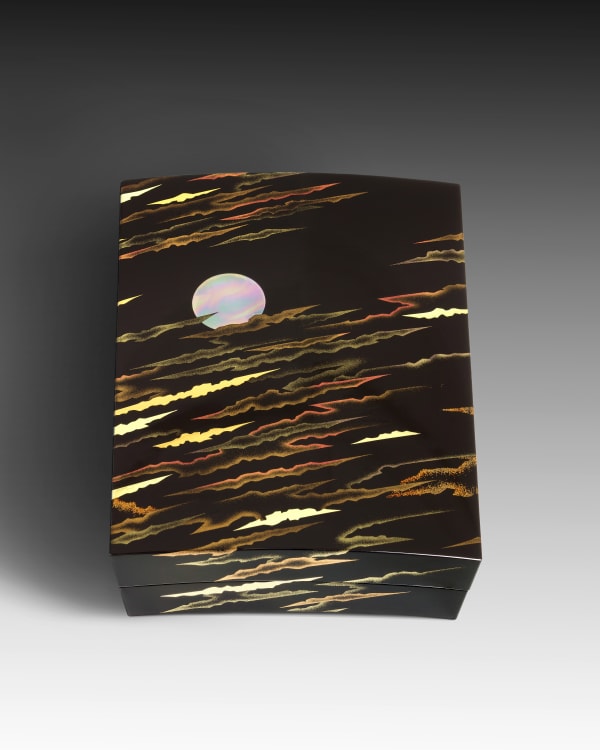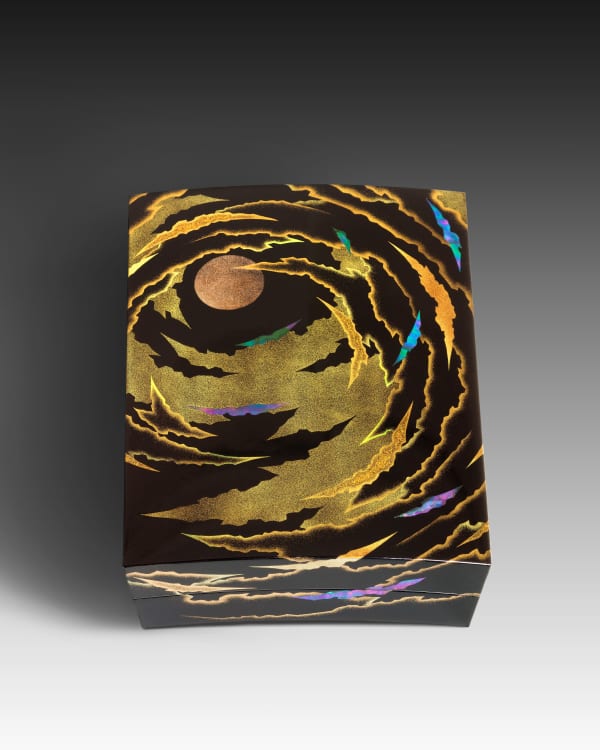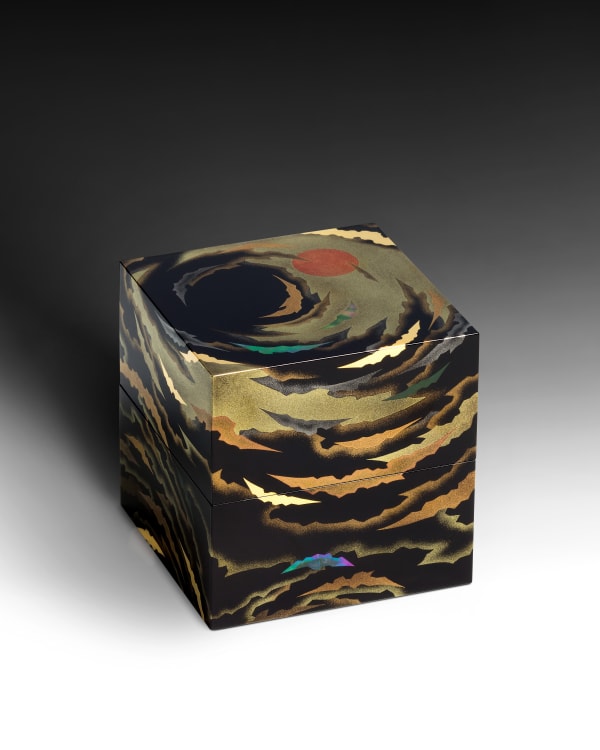-

-
-
Glossary of Lacquer Terminology
Aokin 青金: Mixture of gold and silver powders producing a range of intermediate colors.
Hiramaki-e: Maki-e which has been raised above the surrounding area with layers of lacquer.
Hirame 平目: Small flat flakes of metal used in lacquer decoration.
Kanshitsu 乾漆: Literally “dry lacquer” or “dried lacquer,” a method of building a body from many layers of lacquer reinforced with hemp cloth and modeling them to the desired shape before the lacquer hardens, used by Okada to form many of his boxes.
Maki-e 蒔絵: Lacquer decoration using particles of gold and silver sprinkled onto damp lacquer.
Nashiji 梨子地: Irregularly shaped small flakes of gold or silver suspended at varying angles in clear lacquer.
Takamaki-e: Maki-e which has been raised by mixing lacquer with powdered clay or charcoal and subsequently modeled in relief.
Togidashi maki-e 研出蒔絵: Special maki-e technique, seen in every piece in this publication, in which fine metal powders are repeatedly sprinkled onto still-wet lacquer and then covered with clear or black lacquer and polished until the original motifs re-emerge, flush with the new polished surface.
Tomobako: Fitted box, typically made from kiri (paulownia) wood, commissioned by an artist such as Okada to contain his work and usually bearing an inscription, signature, and seal; artists sometimes commission double nested wood boxes, with the outer box protecting the inner inscribed and signed box.
-
Yoshio Okada (b. 1977)
Career and Awards
1977 Born in Kyoto
1995 Graduated from Kyoto City Dohda Senior School of Arts
1999 Graduated from Lacquer Arts Section, School of Art, Tohoku University of Art and Design, Yamagata
2000 Graduated from the Miyako Technical Institute, Kyoto City Specialist Lacquer Training
2001– Works at the Shiun Lacquer Studio and Lacquer Restoration Studio, Kyoto
2007 Awarded the Newcomer’s Prize at the 36th Traditional Japanese Craft Exhibition, Kyoto-Area Edition
2009 Prizewinner at the 17th Beauty of Urushi Japanese Lacquer Exhibition
2010 Awarded the Governor of Kyoto’s Prize at the 42nd Kyoto Lacquer Exhibition
2016 Awarded the Kyoto City New Artists’ Prize in recognition of his contribution to the cultural life of the city, national critical acclaim, and future potentialSelected Exhibitions
2007 36th Traditional Japanese Craft Exhibition, Kyoto-Area Edition
2008 37th Traditional Japanese Craft Exhibition, Kyoto-Area Edition
2009 17th Beauty of Urushi Japanese Lacquer Exhibition
2010 42nd Kyoto Lacquer Exhibition
2011 Golden Treasures: Japanese Gold Lacquer Boxes, Erik Thomsen Gallery, New York
2012 Japanese Contemporary Lacquer Show by Yūji and Yoshio Okada, Monterey, Calif.
2013 Transparency of Art: Young Nippon Beyond, Rostock, Germany
42nd Traditional Japanese Craft Exhibition, Kyoto-Area Edition
2014 43rd Traditional Japanese Craft Exhibition, Kyoto-Area Edition
2016 Contemporary Lacquer by Yoshio Okada, Erik Thomsen Gallery, New York
2018 Lacquer Works by Yoshio Okada, Thomsen Gallery, New York
2021 Lacquer Art by Yoshio Okada, Thomsen Gallery, New YorkPublic Collections
2013 Art Institute of Chicago, Chicago, Illinois
2018 Nelson-Atkins Museum of Art, Kansas City, Missouri
2018 Yale University Art Gallery, New Haven, Connecticut -
Kyoko Ibe (b. 1941)
Born in Nagoya, in 1941, Kyoko Ibe first worked with washi—traditional Japanese hand-made paper—during the 1960s. She is now one of Japan’s most senior and respected artists in the medium, creating site-specific installations and theater sets that can fill large architectural spaces, as well as more domestic-scale panels and folding screens fashioned out of dyed and pulped antique documents that were originally brushed with handwriting in sumi ink.
These panels and screens combine multiple layers of representation and metaphor. In one sense almost pictorial, they can evoke the night sky, a stormy sea, or a distant mountain range, but each of them also powerfully conveys the artist’s conviction that pre-industrial handmade paper is far superior to its contemporary counterpart and, just like old timber, grows ever more beautiful with the passage of time. The ink that was brushed onto the original documents makes an important contribution, surviving the dyeing and pulping processes and infusing her compositions with varying shades of gray that contribute to a unique aesthetic.
Ibe reveres old paper not only as an almost sacred raw material but also as an embodiment of the traditional Japanese sense of oneness with nature, along with the down-to-earth thrifty virtues of earlier times, when paper was a valued material, rarely discarded and often reused. Now that sustainability is a universal aspiration, Ibe’s concept of her practice as an art of rebirth and renewal has come into its own, giving fresh significance to the old idea of kaikonshi (“paper with its soul brought back to life”) that “expresses and revives our shared human skill and compassion.”
Appointed by the Government of Japan as a Special Advisor for Cultural Exchange, Ibe has worked in many parts of the world as an international ambassador for washi and is well known in the United States for her installations and stage designs. Her solo show “Washi Tales: The Paper Art of Ibe Kyoko” was held at the Los Angeles County Museum of Art in 2011 and in 2016 New York’s Asia Society presented “Recycling: Washi Tales,” a theatrical performance around four tales of paper making, in which Ibe’s work played a prominent role.
Yoshio Okada: Gold Lacquer Boxes
Past viewing_room
